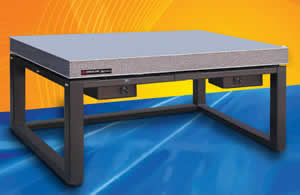
Drug Discovery & Development Online - January 2012
New MK52 Negative-Stiffness Optical Vibration Isolation Table
Minus K Technology, a leading manufacturer of vibration isolation products has partnered with Kinetic Systems, Inc. in designing a new, versatile, ultra-low natural frequency optical table isolation system
The MK52 negative-stiffness optical table achieves 0.5 Hz or lower vertical and horizontal natural frequencies without limiting its ability to support static loads. When adjusted to a 0.5 Hz natural frequency, the MK52 achieves 93 percent isolation efficiency at 2 Hz, 99 percent at 5 Hz, and 99.7% percent at 10 Hz.
 The MK52 Optical Vibration Isolation Table can be configured for a wide variety of locations and applications - wherever external vibrations can adversely affect the operation of sensitive equipment. Ultra-low natural frequencies, high internal structural frequencies, and excellent vertical and horizontal isolation efficiencies make the system well-suited to applications such as analytical balances, cell injection, confocal microscopes, patch clamping, optical microscopes, wafer probing, sensor calibration and laser applications, in fields such as semiconductor processing, telecommunications, aerospace engineering and medical research.
The MK52 Optical Vibration Isolation Table can be configured for a wide variety of locations and applications - wherever external vibrations can adversely affect the operation of sensitive equipment. Ultra-low natural frequencies, high internal structural frequencies, and excellent vertical and horizontal isolation efficiencies make the system well-suited to applications such as analytical balances, cell injection, confocal microscopes, patch clamping, optical microscopes, wafer probing, sensor calibration and laser applications, in fields such as semiconductor processing, telecommunications, aerospace engineering and medical research.
The MK52 is also ideal for applications requiring high resolution, such as Raman spectroscopy, atomic force microscopy (AFM), AFM-Raman integration, and micro-hardness testing.
The MK52 is available in table sizes up to 4' x 8' with gross load capacities up to 2,000 pounds (909Kg) (larger optical table sizes will be considered). Tables are constructed with a 3/16" thick ferromagnetic stainless steel top skin, 3/16" thick carbon steel bottom skin, and plated-steel precision honeycomb core. Customization options include guard rails, padded armrests, overhead equipment shelves, monitor stands, non-isolated shelves for supporting equipment off the tabletop, seismic restraints, auxiliary work surfaces, retractable casters, Faraday Cages, and tabletop enclosures to protect against harsh manufacturing environments.